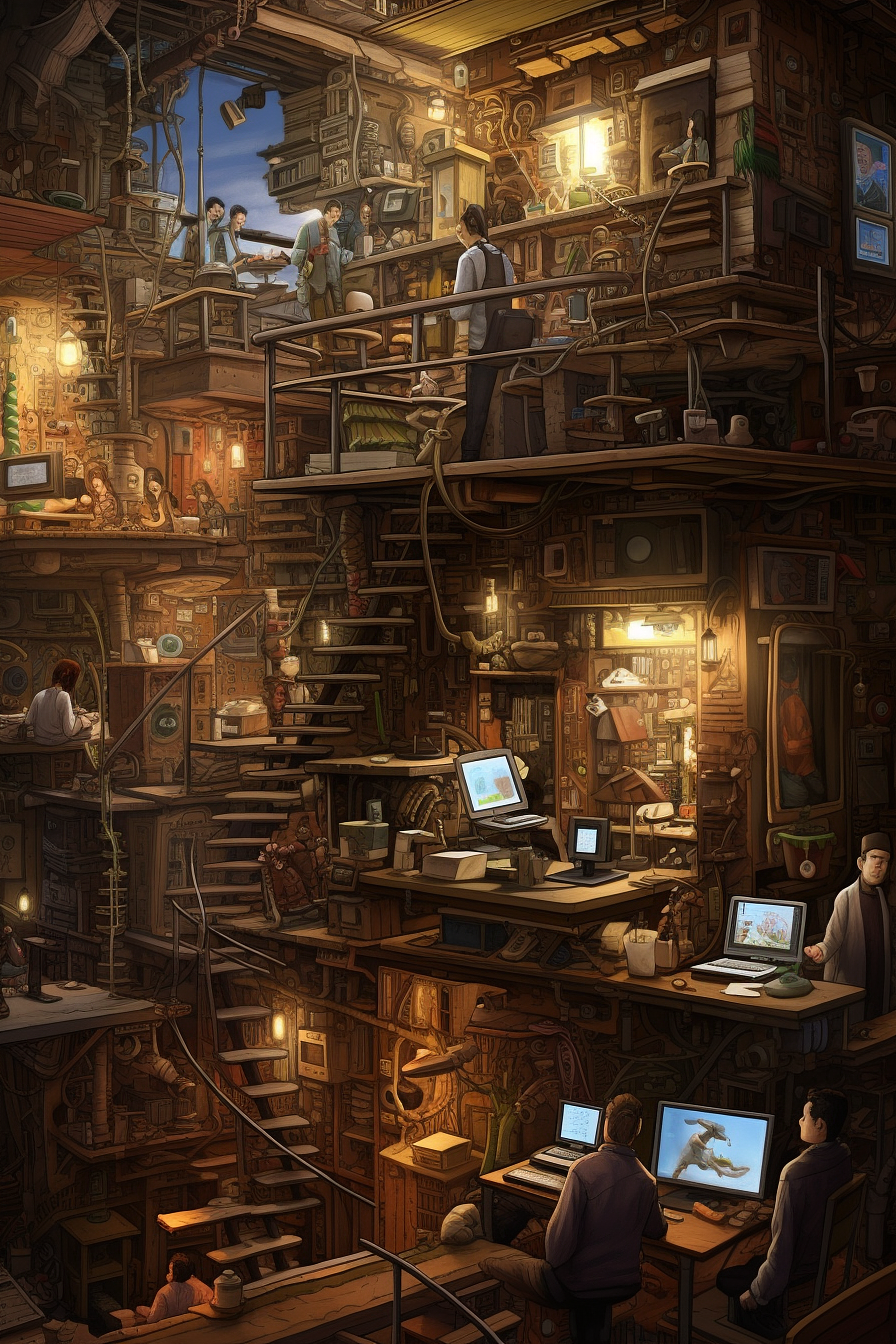
Business In Archviz
Is subcontracting dragging the archviz industry down?
Let's talk about another topic nobody cares about, shall we?
Even though Horoma is a tiny studio, I still receive on a weekly basis emails from freelancers (or "specialized studios") asking me if I want to subcontract some of my workload to them.
On a more rare basis, I will also receive emails from established studios asking me if they can offload some of their contracts to me because they don't have the bandwidth at a certain moment.
I never really paid attention to those emails, but the question always lingered in my mind : is subcontracting really a good practice in a so-called creative industry?
The practice of subcontracting
Before going further, let's define what I mean by subcontracting because there are often subtleties on the matter.
In the case of archviz, subcontracting generally refers to a primary studio giving a whole contract to either another smaller studio or, more commonly, a freelancer. The primary studio will generally stay in charge of the contract with the end client, do the communication, sometimes also do the art direction, and pass on the comments to the subcontracted entity.
I'm not talking about merely outsourcing parts of the process (getting someone to model something, someone to get some site photographs, etc) but really outsourcing the entirety of the image crafting process to a single entity (freelancer, or studio)
As I mentioned in the introduction, even my small practice is getting regular demands of subcontracting in both ways, and after talking with other authorities in the field, it seems that subcontracting is, for better or worse, a pretty standard practice.
The pros of subcontracting
There are of course many incentives to rely on subcontracting, otherwise nobody would do it, right?
Primary studio :
-
Cost efficiency
- Subcontracting can help the primary studio manage costs, especially when dealing with fluctuating workloads.
- After all, in many western countries, it is costly to hire someone in-house, while outsourcing on a contract base will for sure be much cheaper and give that extra flexibility that will better suit the market volatility.
-
Scalibility
- Subcontracting is a flexible way to scale up or down the workforce as needed, enhancing flexibility in project management.
-
Access to specialized skills
- Although less often the case, subcontracting can sometimes be necessary because the studio needs a specific skill that is not available in-house.
Freelancer getting a subcontract :
-
Opportunity for work
- We all know how hard it can be to start out when you're freelancing, and getting a company offloading work to you is often seen as a great opportunity to start making money with your skills
-
Portfolio building
- On a more general basis, the flow of work can help the freelancer build their portfolio, gain experience and potentially lead to more substantial contract in the future, or a fulltime position in the primary studio, who knows?
-
Networking
- Subcontracting is also one way of making contacts with people in the industry and start building professional relationships.
Industry as a whole :
- Market access
Subcontracting can facilitate market access for smaller studios and freelancers, fostering the overall growth of the industry -
Global collaboration
- it encourages global collaboration, bringing together professionals from different regions and promoting diverse design perspectives
-
Innovation
- Subcontracting, when done transparently, can incentivize studios to invest in reasearch, development, and innovation to remain competitive
Well, that's a decent list isn't it? Let's have a look at the negative aspects now.
The cons of subcontracting
Primary studio
Here I'll stay a bit shallow in this part, and extend on the few points that I think are critical in a subsequent chapter.
-
Quality control issues
- Including a new person, outside of your studio, into the process of making images can sometimes lead to quality control issues.
- Although this issue can already arise with in-house artists when you have too much of a discrepancy between "the best" and "the less good (!)" artist.
-
Confidentiality and security concerns
- Outsourcing projects that are sometimes under NDA, or giving temporary access to your asset library can give rise to confidentiality and security issues that can have pretty heavy consequences on your business reliability.
-
Communication challenges
- Talking with your team that is in the same room is not the same thing as talking with another artist that might be on the other side of the world. While of course one could expect that there are some screening before subcontracting to a freelancer, it will always come with its challenges regarding communication since we all have different ways of working and speaking.
Freelancer getting a subcontract
On the freelancer sides, while the pros (making moneeey £££) can seem nice at first, they are still a consequent number of drawbacks that need to be taken into account
-
career development
- It is extremely rare (I say rare even though I think there is a 0% occurence) that subcontracted freelancers are credited for their work even though they did the whole creative and practical work. It also is not rare that they simply can't use those images in their portfolio due to contracts clauses.
- Since a big aspect of your ability to find new clients relies on showing work you've done, all the time you're spending doing work as a subcontractor is work that will not help the growth of your own business. Yes you're making money, but you're passing on everything else.
-
skill development
- While subcontracting can be a good way to develop your technical skills (although these are not paramount), there is one skill that is way more important, that you are not developing : communication.
- Again, it is very rare that freelancers that are getting subcontract get to talk directly to the client. This can be for workflow streamlining issue on the primary studio, this can also be done out of fear of giving away a client. Whatever the reason, not being in direct touch with your client, and not being able to talk to them and have a conversation with them about the image, is preventing you from developing your core business skills : talking to a client, analyzing and discussing a brief, addressing objections, etc.
-
compensation
- Here it can go many ways. Some studios subcontracting have a "fair" practice, and will only take a small commission off of the final fees so that you can actually get a good chunk of the result, provided their pricing is similar to yours.
- I wouldn't be surprised to see other studios, relying more heavily on subcontracting as an actual business model, taking larger chunks of the original fees and regularly changing the subscontractors they work with.
All in all, relying on subcontracting too much will basically prevent you from going on to the next step. You are not getting the full amount of the value you created, you are not networking for potential clients, you are not developing the skills you'll need to lead conversations with clients, you are not developing a portfolio you can show to get new leads.
The sign of poor management
Before diving into the larger scale and see what are the potential drawbacks on the archviz industry as a whole, maybe it's good to stop for a minute on why are studios outsourcing in the first place.
The reason, 99% of the time, studios will subcontract is pretty straightforward : they don't have the bandwidth and don't want to give up on potential contracts.
The solution then is often simple : either we hire more in-house artists (but we covered the fact already that it's expensive), or we can subcontract for that one project.
The issue, when you have a problem and jump to the solution instead of pondering the actual original source of the issue, is that you can be reinforcing bad practices.
As Jessica Hische alludes to in a great blog post about pricing, if all your clients are saying yes to your proposals... then you might be charging (way) too low.
And while it is great to have a constant flow of new and old clients coming, a business that sustainably grows will have to let some of those clients go and get new ones... that can pay more. You can of course be completely fine with the money you're making, and simply turn down new clients and keep things as they are.
Subcontracting, while keeping things as they are though, has a direct, non negligeable, negative impact on the industry as a whole, as we'll see in the next section.
Industry as a whole
If we consider the industry as whole, the practice of subcontracting by a studio that is not running healthily, is doing one simple thing : it validates and reinforces a race to the bottom when it comes to pricing.
If we circle back to the different drawbacks mentioned earlier, as well as some of the potential pros, the overall painting is not that great :
The primary studio is locking itself into a market where their value is getting lower and lower, thus requiring more and more work to break even, thus relying more and more on subcontracting, thus closing the circle of an unhealthy practice.
The primary studio is preventing other studios from flourishing by capting a larger client bases that it "shouldn't" be working for, because they are underselling themselves and could charge higher.
The freelancer is more and more forced into subcontracting because potential clients are already taken by bigger studios charging too low, so their ability to grow is hindered.
The freelancer is getting work from a company that is already charging low, and is therefore lead to charge even lower for their service, whatever the quality and actual perceived value from the end client.
Innovation is hindered because neither the primary studio, nor the freelancer, can carve out time for experimentation and research.
Innovation is also hindered because the client base is concentrated on a smaller and smaller base... that is not innovating.
Over time this leads to the homogenization both of the artistic aspect (or lack thereof), and of low fees despite high value (I'll probably write an article on the topic soon).
The way forward
All in all, on the mid and long term, absolutely noone is benefiting from this type of subcontracting.
But there are ways to make it work for everyone, right?
Now, I genuinely don't care how you run your business (whether you're a freelancer, or a studio). You can of course do whatever you want. The one thing I'm getting tired of, is seeing people on forums, or in different conversations I'm having, complaining about the state of archviz, while at the same time participating actively in what is driving the industry down (and bad subcontracting is just one of the many subjects impacting archviz negatively)
A few things I would emphasize that could potentially fix the negative aspects of subcontracting, while not impacting negatively anyone :
-
Charge properly.
- If you're an established studio getting a lot of work with big names and are charging like you're working alone in your mother's basement, you're a big part of the problem. I get that it can be difficult to let go of clients because you became too expensive, but it's just how the game works. Assess whether you want your business to grow or not, and then act accordingly by either getting new clients and dropping old ones, or simply keeping things as they are and turning away clients that you can't work for. You can also have different pricing range per client in order to transition smoothly.
-
Be transparent
- Be transparent about the fact that you're subcontracting.
- Some clients will not care, others will not work with you because they don't want to pay for your services if it's not you doing the work... which is fair.
- Either way, don't be deceitful towards your clients. It's important to act ethically when building your business.
-
Credit the people working
- In order to not hinder the growth of freelancers, make sure to credit them so that they can boast the work they do for you on their portfolio. I know you get annoyed when your client is not crediting your work. So don't do it to others.
-
Bring them to the table
- In the spirit of transparency and growth, I think it's also good to bring the person you're subcontracting to the table when discussing with the client. Of course this has to fit within the way you run your practice, but outside artists should be treated the same as inhouse artists.
-
Help when you can
- Now this one always surprises people. But if you can't get a client, rather than forcing them into your schedule and client base, simply refer to other artists or studios you like.
- I genuinely don't understand the mindset of trying to keep a client to yourself, proposing subpar results, putting pressure on your structure and leading you to make poor decisions that will affect all your current employees, all this for what? Not even necessarily retaining a client because they will eventually go elsewhere where they are treated better by people that actually have the bandwidth?
- Other freelancers will be grateful. Clients will aslo be grateful and will come back to you anyway because they wanted to work with you in the first place.
- And at least you're giving more autonomy to emerging studios that need it in order to grow and lift the archviz industry up.
If you're a studio often relying on subcontracting, try to implement those rather simple changes.
If you're a freelancer trying to get such contracts, try to push for this type of deal so that you're not shooting yourself in the foot.
So, is subcontracting dragging the industry down? Definitely yes, if done poorly, which is often the case.
Even in instances where it's big wealthy studios subcontracting other big healthy studios, I still hear about some weird issues regarding transparency and crediting.
Luckily for us, there are simple ways to address this that will mostly bring benefit for little sacrifice, and the sacrifice lands on studios that are already doing well, which minimizes it even more.
Again, I'm not here to point fingers and blame people for running their business the way they run it. Most of the time, there is a sensible reason to do so. Most of the time though, there is also a lack of understanding of the impact on the bigger picture, and how it's going to bite you back in the ass later down the road.
I hope this article brings some clarity so that everyone can act accordingly. Change the practice if you were not aware of the consequences. Or stop whining if you see that you're actually part of the problem but don't want to change your practice :)
Whether the archviz industry keeps growing and innovating or not is down to how each of its constituent choose to act on a daily basis. Fairness, transparency and community-driven approach can go a long way in making archviz a cool, yet profitable, industry to work in.
Cheers
Simon
Simon
If you want a long-ass stance on the business aspect of archviz (on top of other things), you can check out my course From The Ground Up.
You must be logged in to post a comment. Login here.
About this article
The current trend in subcontrating in the industry of archviz has created a downward trend on multiple aspects of the field. Some insights on the often discarded consequences of poor subcontracting, and how to mitigate them.
visibility714
favorite_border0
mode_comment1









Interesting article. Some great points. I would love to see them implemented but unfortunately i see more segregation, I hope I am wrong.